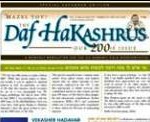 Twenty years in the making, the Orthodox Union Kashrut Division this month is celebrating the 200th issue of The Daf HaKashrus — its highly technical newsletter for OU Rabbinic Field Representatives (RFR’s) around the globe — with a special expanded edition.
Twenty years in the making, the Orthodox Union Kashrut Division this month is celebrating the 200th issue of The Daf HaKashrus — its highly technical newsletter for OU Rabbinic Field Representatives (RFR’s) around the globe — with a special expanded edition.
Rabbi Menachem Genack, Chief Executive Officer of OU Kosher, who is actively involved in editing The Daf, noted, “The Daf HaKashrus has served as the essential vehicle to communicate kashrut information and elucidate current important kashrut issues. The proper flow of information is the core of a successful kashrut organization, and after reaching this two hundredth milestone, OU Kosher aspires to further growth in disseminating Torah information and enhancing kashrut standards.”
Rabbi Yosef Grossman, whom Rabbi Genack deemed more than just the Editor of The Daf Kashrus — but the Father of The Daf since its inception 20 years ago — stated, “The Daf HaKashrus began in June 1992, as a means of disseminating OU standards, new information, and current events in fields relevant to kashrut, to all OU RFR’s around the globe on a monthly basis. It has expanded over the years to be received by kosher consumers, rabbinic and communal figures, and kollels.”
Rabbi Moshe Elefant, OU Kosher Chief Operating Officer, and Rabbi Yaakov Luban, OU Kosher Executive Rabbinic Coordinator, also serve as editors of The Daf HaKashrus. Raizy Rosenfeld, the graphic designer for the publication, has worked with Rabbi Grossman on The Daf for more than ten years and is responsible for bringing the newsletter from black and white prints, to the colorful email received by thousands.
Rulings by OU poskim (halachic decisors) Rav Yisroel Belsky and Rav Hershel Schachter are noted and explained within large portions of the monthly Dafs. Submissions for publication within The Daf HaKashrus are open to all OU Kosher staff worldwide. The inclusion of “Letters of Appreciation,” “Mazal Tovs” and “Condolences” allow for greater familiarity and geniality amongst OU Kosher colleagues around the world. In addition to intense commentary onhalacha, The Daf also reprints press releases from the Orthodox Union Public Relations Department written for general audiences on the various programs of OU Kosher; as well as articles from Behind the Union Symbol, the semi-technical magazine written for OU-certified companies.
Articles within the special 200th Daf HaKashrus issue include, “Odd-Numbered Fatty Acids” and “Enzyme Modified Cheese Flavors” By Rabbi Gavriel Price, OU Rabbinic Coordinator; “When is Bishul Yisroel Really NOTBishul Yisroel? By Rabbi Chaim Goldberg, OU Rabbinic Coordinator; “With an Abundance of Soap” by Rabbi Zushe Yosef Blech, Rabbinic Administrator of Earth Kosher; “Consumer Q & A;” and “Creating the Best Possible Relationship with Kashrut Agencies Worldwide,” by Rabbi Dovid Heber, former OU Rabbinic Coordinator and current Kashrut Administrator for Star-K Kosher Certification.
This special edition, Rabbi Grossman explained, contains many articles from gifted writers and kashrut experts who are either currently, or were previously, employed by the OU (such as Rabbis Blech and Heber). “I take this opportunity to thank everyone who contributed articles to this volume and the past 199 issues of The Daf for their insightful and educational contributions. Kosher consumers, Rabbinic Field Representatives (RFR’s), Rabbinic Coordinators (RC’s) and communal rabbis owe a tremendous debt of gratitude to these writers for 20 years of outstanding material,” he shared.
Rabbi Grossman reflects within his Editor’s Letter, “I am highly gratified that many individuals have approached me over the years in person, or by other means of communication, to express the pleasure and educational value they have had from The Daf HaKashrus of OU Kosher. May I merit to edit The Daf for many years to come – after all, he who edits 200 issues of The Daf, looks forward to 400 as well.”
A Selection From the 200th Special Edition of the OU Kosher Daf HaKashrus:
ENZYME MODIFIED CHEESE FLAVORS
By Rabbi Gavriel Price, OU Rabbinic Coordinator
About thirty years ago a fast-food chain was searching for a cost-effective way to boost the flavor of the processed cheese slice complementing the hamburger patty on its signature product. Adding flavor to the cheese was not an option because the FDA would not permit flavor substitutes in a product called “cheese”. The ingredient would have to come from cheese itself. Blending in aged cheese, which is full of flavor, was also not an option, because it failed the cost-effective criterion – the aging process is expensive. The company commissioned Dr. N.R. Gandhi, a biochemist at Utah State, to find a solution.
Dr. Gandhi came up with a novel ingredient that was derived from cheese, imparted the full flavor profile of aged cheese, but was dramatically less expensive than aged cheese itself. Using a small handful of industrially-synthesized enzymes and adjusting conditions of its preparation, he accelerated the aging process and produced a cheese concentrate in two days, as opposed to the many months it would ordinarily take.
The ingredient was accepted by the FDA for addition to pasteurized processed cheese (more commonly referred to as “American cheese” or “cheese slices”) and dubbed “enzyme modified cheese flavor.” Dr. Gandhi and his wife went on to found a specialty ingredients company, Jeneil Biotech, in Saukville, WI, which is certified by the OU. Enzyme modified cheese is now produced by a number of companies.
Not only is the process novel, the halachic consequences are as well. The Rema (Y.D. 89, 2) rules that just as a person should wait six hours after eating meat before eating dairy, a person should wait after eating hard cheese before eating meat. The Shach cites Toras Chatas, which states that cheese aged six months can be assumed to have developed an intensity that would require a person who ate it to wait six hours (or according to his custom) before eating meat. Poskim understand this to mean that the types of cheeses that are typically aged for six months can be assumed to be flavorful enough that a person who eats it should wait before eating meat, but if a product could be prepared in a shorter amount of time, with the same result, it would, of course, be subject to the restriction cited by the Rema (see, for example, Pri Megadim, M.Z. 89, 4). The OU poskim follow this position – that six months is not an absolute number, but rather an indication of how long cheese should age before someone who eats it is constrained in what he eats. Enzyme modified cheese would be an example of this kind of process.
EMC is not cheese proper, however, but a liquid cheese concentrate. It is added, as such, to cheese slices, as well as to other products such as dressings and sauces. This means that, practically speaking, we can rule out the possibility that a consumer would encounter enzyme modified cheese in a form that would actually require him to wait six hours. Yad Yehuda (Y.D. 89, 30) writes that the requirement to wait after eating strong (or hard) cheese applies only to גבינה בעין and not to a תבשיל של גבינה. As relates to the stringency of waiting after eating hard cheese, we can define aתבשיל של גבינה as something in which cheese is either not in it at all (that is, the cheese has been removed) or the cheese is blended in (and not identifiable) and is a מיעוט of the תבשיל (heard from Rav Schachter, shlita). Since a liquid form of enzyme modified cheese flavor is always a מיעוט, eating a product containing it would not mean that a person would have to wait any time at all before eating meat.
EMC can also be spray-dried, however, and made into a powder. In this form it is incorporated into a seasoning and added to crackers, popcorn, chips, and other snacks. The OU certifies crackers with a parmesan and peppercorn seasoning, popcorn with parmesan seasoning and similar products. In this case the cheese is בעין, and if the seasoning is primarily either genuinely aged parmesan (or another aged) cheese or enzyme modified cheese then a person eating the cracker should wait six hours before eating meat. According to product specialists at companies that handle enzyme modified cheeses, however, specialized cheese seasonings such as parmesan often contain other bulkier ingredients, such as whey or blander cheese flavors, as a primary ingredient. Therefore, in these cases, the specialized would be a מיעוט of the seasoning and not necessitate waiting after eating it, before eating meat.
Rav Schachter’s teshuva on this topic can be found in I-209.
How Does Enzyme Modified Cheese Work?
Enzyme modified cheese flavor starts with “fresh” or “unripened” cheese – cheese which has not yet had the opportunity to age, and therefore lacks flavor. The distinctive and complex flavors we associate with cheese are the result of a broad cascade of biochemical and chemical reactions initiated by microflora naturally present in fresh cheese curd. The result is hundreds of chemicals that constitute the flavor profile of a given cheese.
These processes take place over time. Cheddar cheese must be aged at least two months before it assumes the identity we associate with it; Romano, five months, Reggiano and parmesan, ten. Time costs money. The key question for a food chemist is how to unlock the flavor latent in fresh cheese without having to wait for the natural processes to perform this task on their own. More simply: can the process be accelerated?
Enzyme technology provides a solution. Enzymes are biological chemicals that catalyze biochemical reactions. They are the agents of change in biological processes, including those responsible for the natural development of flavor in cheese. Since the mid-twentieth century, advances in understanding how enzymes work have provided scientists with ways of isolating and developing enzymes that could be used for diverse industrial applications, including the food industry. In many of the applications the industrially-produced enzymes are used simply to accelerate – by many orders of magnitude- processes that would have otherwise evolved without them.
The use of enzymes in fresh cheese follows this model. As cheese naturally ages, the microflora naturally present in the curd release enzymes – among them lipases and proteases — that break down milk fat and milk proteins to yield chemicals like fatty acids and amino acids that form just a portion of the constituents of a cheese’s flavor profile. In the production of enzyme modified cheese flavor, industrially-made enzymes, including lipases and proteases, modify the fresh cheese they’re added to by powering the biochemical processes that would have otherwise run their course. The principal job of a mashgiach at an enzyme modified cheese company is to ensure that the enzymes, which are extremely kosher-sensitive, are approved.
A number of complex processing and ingredient considerations play a role in enabling enzyme modification processes to occur. The fresh curd must be grated and pasteurized and various ingredients are added. Temperature and length of incubation, timing of addition of the enzymes, and selection of the enzymes are some of the factors that contribute to the development of a targeted flavor profile. When the right conditions are in place, an enzyme modified cheese flavor can be produced in one to four days, as opposed to months.
{Noam Amdurski-Matzav.com Newscenter}












I still would liek to know how to subscribe to the Daf haKashrus. I emaield the ou but no response.